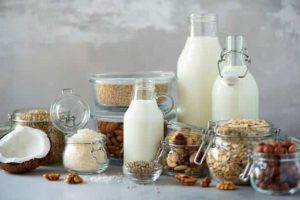Don’t consume too much dairy
Dairy fits well in a ketogenic lifestyle; it’s a good source to get some extra fats and, let’s be honest, it’s delicious. However, it’s not advisable to go overboard with blocks of cheese, bowls of whipped cream, and so on. In this article, I’ll explain why this is the case.
Table of Contents::
- Suitable Dairy Types
- What is Lactose?
- It Varies by Product
- How Much Dairy Can You Have Per Day?
- Alternatives to Dairy
Suitable Dairy Types
Let me start by explaining that not all forms of dairy are suitable for a ketogenic diet. Several dairy products contain significant amounts of carbohydrates alongside fats and proteins. Additionally, the quantity you consume can vary by product. When you drink something, you tend to consume more compared to when you eat it.
What is not suitable, for instance?
Take milk as an example; it typically contains about 4.5 grams of carbohydrates per 100 ml. A standard drinking glass holds approximately 250 ml, which means that one glass of milk can easily provide you with over 11 grams of carbohydrates.
Considering that most people following a ketogenic lifestyle typically consume between 20-50 grams of carbohydrates per day, there’s very little room left for vegetables, and excess lactose can also kick you out of ketosis.
Another example is having a large bowl of yogurt or quark for breakfast every morning, which is roughly 250 grams. With one serving, you quickly exceed the recommended daily limit of dairy consumption. Moreover, it leaves you with limited carbohydrates for vegetables.
Should you avoid dairy altogether?
You could consume small amounts of milk, for instance, by adding it to recipes. Nevertheless, it’s better not to do so. Instead, you can replace it with liquid, unsweetened cream, which is lower in carbohydrates and higher in fats, aligning better with a keto diet.
You can have yogurt or quark in limited quantities, but it’s advisable not to have a bowl daily. My preference is to use them sparingly as additions to dishes rather than as main components.
What is Lactose?
Dairy contains lactose, which is a milk sugar, as the name suggests: sugar. Even if the packaging states that the number of carbohydrates and sugars is 0, lactose is converted into sugar in your body.
Since your body converts lactose into sugar, there is a chance that excessive lactose consumption could push your body back into sugar metabolism instead of fat metabolism. This means that excessive dairy consumption might lead to exiting ketosis.
Dairy products also tend to be rich in protein. Excessive protein intake can also potentially lead to exiting ketosis. You can read more about this in this article.
It Varies by Product
The amount of lactose varies from one product to another.
Products with low lactose content:
Aged and harder cheeses like Parmesan contain almost no lactose. Many people with lactose intolerance can tolerate Parmesan cheese. However, these hard cheeses also contain less fat, making them higher in protein compared to fat, which is not ideal for a keto lifestyle.
Products with high lactose content:
Young and soft cheeses, liquid cream, milk, yogurt, and others contain relatively high levels of lactose. They are also higher in fat.
How Much Dairy Can You Have Per Day?
The advice is to limit your daily dairy intake to a maximum of 100 grams per day. With this amount, you are essentially staying ‘safe’ to avoid exiting ketosis and prevent an excess of calories. However, if you’ve been at a standstill on the scale for a considerable time, it might be helpful to refrain from dairy entirely for a short period to see if that might be the stumbling block. You can read more about weight stagnation and tips to resolve it in this article.
Dairy Alternatives
If you really can’t do without your bowl of yogurt for breakfast or you want to make a dish that includes both cheese and something like cooking cream, there are several alternatives you can use to replace dairy products.
Yogurt
When I crave a bowl of yogurt, I personally go for Alpro’s unsweetened Mild & Creamy soy variant. Since this product contains no dairy and no carbohydrates, I find it ideal. However, this product is relatively higher in protein than in fats, so I make sure to include fatty foods with it, such as a handful of nuts, ground flaxseed, or avocado.
Another alternative for yogurt is coconut-based yogurt. There are various brands of this available in supermarkets these days. Keep in mind that it has a slight coconut flavor and does contain some carbohydrates. The amount of carbohydrates varies between brands, so be sure to compare the labels! Make sure they are unsweetened variants and not only check the nutritional values but also the ingredients. You can learn more about reading labels in this article.
Liquid Dairy
This includes products like milk, cream, and cooking cream.
There are also various plant-based options available for these. Some are soy-based, but you can also find options based on nuts (like almond milk) or coconut. Once again, compare different brands, ensure they are unsweetened variants, and check not only the nutritional values but also the ingredients.
Note: Opinions are divided on how healthy/unhealthy it is to consume soy products daily. I believe it’s a fine occasional alternative as long as you don’t make it a daily habit to consume a pack a day. If you are sensitive to soy, it’s best to avoid it, as it can negatively affect hormone balance, leading to various issues.



